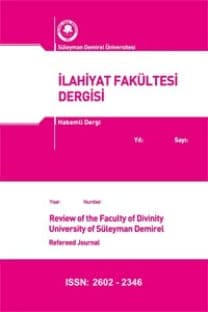Farklı Arap Lehçelerinde Önekler: Fasih Arapça İle Karşılaştırmalı Bir Çalışma: Şimdiki ve Gelecek Zaman
Arap Dili Lehçeleri, Biçimbilim, Önekler, Şimdiki Zaman, Gelecek Zaman, Toplumdilbilim, Karşılaştırmalı Dilbilim
Prefixes in Various Arabic Dialects in Comparison of Standard Arabic: Progressive and Future Tenses
Arabic Dialects, Morphology, Prefixes, Progressive Tense, Future Tense, Sociolinguistics, Comparative Linguistics,
___
- Quran Karim
- Abdel-Malek, Zaki N., the Closed List Classes of Colloquial Egyptian Arabic, Hague, Mouton, 1990.
- Aboul-Fetouh, Hilmi M., a Morphological Study of Egyptian Colloquial Arabic, The Hague, Paris, Mouton, 1969.
- AlKhalesi, Yasin M., Iraqi Phrasebook: The Essential Language Guide for Contemporary Iraq, McGraw-Hill, New York, 2004.
- Bakalla, M. H., the Morphological and Phonological Components of the Arabic Verb (Meccan Arabic), Longman, London, 1979.
- Behnstedt, Peter, “Sprachatlas von Syrien”, Encyclopedia of Arabic Language and Linguistics, I-V, Brill, Leiden, 2006, I p. 605.
- Blanc, Halim, Communal dialects in Baghdad. Center for Middle Eastern Studies of Harvard University, Cambridge, USA, 1964.
- Brustad, Kristen, the Syntax of Spoken Arabic: A Comparative Study of Moroccan, Egyptian, Syrian, and Kuwaiti Dialects, Georgetown University Press, Washington, DC, 2000.
- Buckley, R., Modern Literary Arabic: a Reference Grammar, Librairie du Liban Publishers, Beirut, 2004.
- Cantineau, Jean – Youssef Helbaoui, Manuel élémentaire d'Arabe Oriental (parler de Damas), Klincksieck, Paris, 1953.
- Cantineau, Jean, Le Dialecte Arabe de Palmyre, Institut Français de Damas, Beirut, 1934.
- Cantineau, Jean, Les Parlers Arabes du Hōrân, [1], Notions générales, grammaire, Librairie C. Klincksieck, Paris, 1946.
- Chejne, Anwar G., The Arabic Language: It’s Role in History, University of Minnesota Press, Minneapolis, 1969.
- De Jong, Rudolf, A Grammar of the Bedouin Dialects of Central and Southern Sinai, brill, 1999.
- El-Hajjé, Hassan, Jean Cantineau, Le parler arabe de Tripoli (Liban), Klincksieck, Paris, 1954.
- Elshorbagy, Nedal, the Prefixes in Urban Arabic Dialect in Gaza: Morphological Study, Lambert Academic Publishing, Saarbrücken, Germany, LAP, 2011.
- Elverskog, Liljana, Verb Morphology in Educated Spoken Arabic, UMI Dissertation Services, Ann Arbor, 1999.
- Erwin, W. M., a Basic Course in Iraqi Arabic: With Audio MP3 files, Georgetown University Press, Washington, D.C., 2004, p. 118.
- Farris, Amal, Diglossia in Arabic Speech Communities: The Classical Language Compared With the Syrian Vernacular, 1975, p. 11, (ERIC Document Reproduction Service No. ED117975) Retrieved May 6, 2009, from ERIC database)
- Ferguson, Charles A., “Diglossia”, Word, 1959, vol. 15, no. 2, pp. 325-340
- el-Fiki, Saad Kariim, 400 Su’aal fil-Nahw, Ed-Daar El-ʕAalamiyye lil-Nashr wet-Tawzii’, Al-İskanderiyye, (s. n.)
- Hasanayn, Ahmad Tahir – Kamel, Mona, Let's chat in Arabic = Yalla-ndardish bi-lʻArabi : a practical introduction to the spoken Arabic of Cairo, A. Hassanein, M. Kamel, Cairo, 1998.
- Holes, Clive, Colloquial Arabic of the Gulf and Saudi Arabia, Routledge & Kegan Paul, London, 1984.
- Holes, Clive, Gulf Arabic, Routledge, London, New York, 1990.
- Ingham, Bruce, Najdi Arabic: Central Arabian, John Benjamins Publishing, Amsterdam, 1994.
- Marcais, Phillipe, Esquisse grammaticale de l‟Arabe Maghrebin, Librairie D'Amerique et D'Orient, 1977, p. I-II.
- McCarthy, R. J. – Raffouli, Faraj, Spoken Arabic of Baghdad. Part one: grammar and exercises, Librairie Orientale, Beirut, 1964.
- McLoughlin, Leslie. J., Colloquial Arabic (Levantine), Routledge & Kegan Paul, London, 1982.
- Mebkhut, Saad Saud, Usuul Lehjet el-Bahrayn: Diraasa Lughawiyyeh Teerikhiyyeh Sarfiyyeh Nehwiyyeh, S. S. Mebkhut, Bahrain, 1993.
- Palva, Heikki, “Dialects: classification”, Encyclopedia of Arabic Language and Linguistics, I-V, Brill, Leiden, 2006, I, p. 604–613.
- Persson, Maria, “The Role of the B- Prefix in Gulf Arabic Dialects as a Marker of Future, Intent and/or Irrealis”, Journal of Arabic and Islamic Studies, vol. 8, 2008, p. 26-52.
- Qafisheh, H. A., a Basic Course in Gulf Arabic, Tucson: University of Arizona Press, 1975.
- Sowayan, Saad A., the Arabian Oral Historical Narrative: An Ethnographic and Linguistic Analysis, Otto Harrassowitz, Wiesbaden, 1992.
- Talmon, Rafael, “Preparation of the Northern Israeli Arabic Sprachatlas”, Encyclopedia of Arabic language and linguistics, I-V, Brill, Leiden, Boston, 2006: I, p. 583.
- Watson, Janet C. E., the Phonology and Morphology of Arabic, Oxford: Oxford University Press, 2002.
- Yayın Aralığı: Yılda 2 Sayı
- Başlangıç: 1994
- Yayıncı: Süleyman Demirel Üniversitesi
LÜZÛM VE DİLSEL İLETİŞİMDEKİ ETKİSİ
GENÇLERE YÖNELİK DİNÎ YAYINCILIKTA DİL VE TERMİNOLOJİNİN ÖNEMİ -KUR’AN ÇEVİRİLERİ ÖRNEĞİ-
SEXTUS EMPİRİCUS’UN KAVRAM TEORİSİ ELEŞTİRİLERİ
SÂHİB B. ABBÂD’IN ŞİİRLERİNDE HZ. ALİ’YE YÖNELİK MEDİHLER
Muhammed ÇUÇAK, Abdurrahim KAPLAN
